CONTACT:
Hilari Graff at Strategic Vision
Tel: 914-881-9056/9020
hgraff@strategicvision.org
IMPERIAL TOURS LAUNCHES GROUP TOUR BOOKING PROMOTION
Travelers Enjoy Either $150 P.P. Credit for Air/Hotel or Champagne Dinner
SAN FRANCISCO, CA (February 10, 2011) – To help drive bookings of Imperial Tours’ 2011 escorted group journeys, the company has launched a special promotion – when four or more people book one of the Majestic, Imperial or Unique Destinations scheduled group departures, guests have the choice of one of the following amenities:
The promotion is valid on all new bookings of the Majestic, Imperial and Unique Destinations tours for travel in 2011. Benefits are based on an individual basis and do not need to be the same for the group.
Group Tour Portfolio
As with Imperial’s bespoke individual journeys, the company’s regularly scheduled group tours reflect the hallmarks of any Imperial trip – exceptional accommodations, superior sightseeing, enriching travel experiences, and unparalleled service. Departures of the scheduled tours are limited to 16 people.
Below is a list of 2011 tour dates and pricing for Imperial Tours’ scheduled group departures:
Dates: June 7 – 19 (guaranteed departure)
Price: $8,585 per person, double, + $1,065 per person for domestic economy air
Dates: April 14 – 24, May 12 – 22, and October 13 – 23 (departures are guaranteed)
Price: $7,230 per person, double + $1,075 per person for domestic economy air
Dates: September 12 – 22 (a six-person minimum is required)
Price: $8,735 per person, double + $1,105 per person for domestic economy air
Imperial Tours – Traveling China…in Style
The leading luxury tour operator based in China, Imperial Tours offers customized private tours and scheduled escorted group departures that combine local expertise with the high levels of service and quality expected by sophisticated Western travelers.
Unmatched in the industry with its breadth and depth of resources, Imperial Tours offers two types of bespoke FIT vacations – Ultimate China and China Escapades. Ultimate China is ideal for those seeking a ‘hosted’ luxury experience and where the ‘best of the best’ is a priority. A bilingual Western China Host accompanies travelers throughout an Ultimate China itinerary to ensure a flawless experience. China Escapades is targeted to independent and adventurous travelers seeking greater autonomy and who are more price sensitive. They desire to explore China’s intriguing sights, sounds and culture with a less mediated experience in a destination.
A member of Virtuoso and Signature, Imperial has been named to Travel + Leisure’s ‘A’ List of Super Agents every year between 2002 and 2010 and distinguished as a ‘top travel specialist’ by Condé Nast Traveler from 2008 – 2010.
Contact Information
For more information, please call (888) 888-1970, send an e-mail to margot@imperialtours.net or visit www.imperialtours.net. Become a fan of Imperial Tours on Facebook at http://tinyurl.com/imperialtours.
Note to Editors
High-resolution digital images of Imperial Tours/China are available upon request.
To help drive bookings of Imperial Tours’ 2011 escorted group journeys, the company has launched a promotion — when four or more people book one of the Majestic, Imperial or Unique Destinations scheduled group departures, guests have the choice of one of the following amenities: $150 per person credit, which can be applied to Diplomatic Channel Access upon international arrival; upgrading to First Class on all for internal China flights or upgrading to suites in all the hotels; or one dinner with champagne for one of the free nights in Beijing or Shanghai (up to $125 per person). The promotion is valid on all new bookings of the Majestic, Imperial and Unique Destinations tours for travel in 2011. Benefits are based on an individual basis and do not need to be the same for the group.
The 2011 tour dates and pricing for Imperial Tours’ scheduled group departures are the 12-night Imperial Tour visiting Beijing, Xian, Guilin, Hangzhou and Shanghai, running June 7 to 19 (guaranteed departure) from $8,585 per person, double, plus $1,065 per person for domestic economy air; the 10-night Majestic Tour, a shorter version of the Imperial Tour, it visits Beijing, Xian, Guilin and Shanghai and runs April 14 to 24, May 12 to 22, and Oct. 13 to 23 (departures are guaranteed), from $7,230 per person, double plus $1,075 per person for domestic economy air; and the 10-night Unique Destinations exploring Southwestern China and Tibet and visits Chengdu, Lijiang, Shangri-la and Lhasa running Sept. 12 to 22 (a six-person minimum is required), from $8,735 per person, double plus $1,105 per person for domestic economy air.
A member of Virtuoso and Signature, Imperial has been named to Travel + Leisure’s “A” List of Super Agents every year between 2002 and 2010 and distinguished as a “top travel specialist” by Condé Nast Traveler from 2008 to 2010. For more information, call 888-888-1970, email margot@imperialtours.net or visit http://www.imperialtours.net/.
TRAVEL EDITOR'S NOTE: Sue Naessens (a former guest of Imperial Tours) is on the staff at Redeemer Lutheran Church. Her husband, Jim, works in health care policy and research at the Mayo Clinic
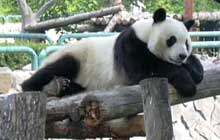 China boasts many treasures with its long history and rich cultural heritage. The Great Wall, theTerracotta Warriors and Forbidden City readily come to mind. Museums overflow with art of every genre. Silk embroidery is nationally famous. Classical gardens, spectacular scenery, delicious food…. what more could one wish for?
China boasts many treasures with its long history and rich cultural heritage. The Great Wall, theTerracotta Warriors and Forbidden City readily come to mind. Museums overflow with art of every genre. Silk embroidery is nationally famous. Classical gardens, spectacular scenery, delicious food…. what more could one wish for?
Pandas!
Pandas are truly a national treasure of China, especially as they are an endangered species. My husband Jim and I love animals, so when we began planning our trip, seeing pandas was a high priority. Discovering however that most package tours rarely include even a visit to a zoo, we began investigating independent travel.
Margot Kong of Imperial Tours ( www.imperialtours.net ) helped us put together the trip of a lifetime by tailoring an itinerary to our interests. We enjoyed a cruise on the Yangtze and visited seven cities, one of which was Chengdu, capital of Sichuan province, home to the giantpanda.
Just north of Chengdu, we visited the Giant Panda Breeding Research Base. It covers 600 acres and supports a team of 48 scientists and technicians who conduct research on reproduction, genetics and endocrinology, disease control, behavior and nutrition. They maintain a captive population of about 40 pandas and release their offspring into the wild at an appropriate time. They also educate the public on conservation issues and provide leadership to facilitate scientific conferences. Researchers from Britain, the United States and Japan have conducted studies there.
What a wonderful facility. In a beautiful, park-like setting we observed pandas at play, climbing trees and eating bamboo. We visited the nursery and saw three infants less than a month old kept in incubators. A newborn cub is roughly the size of a gopher with delicate white fuzzz covering pink skin. By three weeks, it will have grown to the size of a small guinea pig and will have begun acquiring the black and white markings so distinctive to the species.
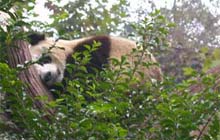 During a video presentation, we watched a panda giving birth at the research base. It happened very quickly; the baby simply popped out and it had about as much effect on the mother as if she were blowing her nose! (I was envious!) A first time mother, the female didn't fully grasp what had happened. We held our breath as she began batting her newborn around the cell as if it were a plaything. The infant was quickly rescued by research staff and gradually re-introduced to its mother. Once she caught on, the female was very nurturing. A new mother will usually hold her baby continually for several weeks. Sometimes she may play with the cub by rolling it around or tossing it back and forth between her paws.
During a video presentation, we watched a panda giving birth at the research base. It happened very quickly; the baby simply popped out and it had about as much effect on the mother as if she were blowing her nose! (I was envious!) A first time mother, the female didn't fully grasp what had happened. We held our breath as she began batting her newborn around the cell as if it were a plaything. The infant was quickly rescued by research staff and gradually re-introduced to its mother. Once she caught on, the female was very nurturing. A new mother will usually hold her baby continually for several weeks. Sometimes she may play with the cub by rolling it around or tossing it back and forth between her paws.
Typically, pandas live about 20 years, subsisting on a diet primarily of bamboo. Cubs will stay with their mothers for 18 months. They mature at 5 years and may begin to mate. Pandas have an extremely limited breeding season, approximately one to three days per year. This contributes to the endangering of the species along with poaching and destruction of natural habitats. Sometimes pandas get tangled in traps intended for other animals, causing injury and making them more vulnerable to natural predators.
Red pandas, or "lesser pandas", are also studied at the base. Much smaller than the giant panda, they resemble raccoons. They live about 17 years in captivitiy and eat, not only bamboo, but also grasses, roots and berries, and sometimes even young birds or small rodents.
Our visit culminated with the opportunity to hold and play with Yaxing (pronounced "ya-shing"), a 1-year-old, 40-pound female cub! We had to put on a special gown and gloves, not for our benefit, but to protect the bear.
Yaxing was very friendly and playful. She acted like a puppy, batting and nipping at our hands. Of all the highlights we experienced on the tour, this was certainly the most endearing.
Although our time in Chengdu represents only a small segment of our trip, the memories incurred there are anything but small. Pandas indeed are to be counted among the treasures of China.
Explore the many amazing World Heritage sites throughout China. View our full blog post for more details.
|
|
||||||||||||||||||||||||||||||||||||||||||||||
In about 220 B.C., under Emperor Qin Shin Huang, sections of fortifications which had been built earlier were joined together to form a united defence system against invasions from the north. Construction continued up to the Ming dynasty (1368-1644), when the Great Wall became the world’s largest military structure. Its historic and strategic importance is matched only by its architectural value. The Great Wall stretches across Northern China. Visitors most commonly see it at one of four sites north of Beijing. For more information about the Great Wall, please click here . Click to go back to top .
No doubt thousands of statues still remain to be unearthed at this archaeological site, which was not discovered until 1974. Qin (d. 210 B.C.), the first unifier of China, is buried, surrounded by the famous terracotta warriors, at the centre of a complex designed to mirror the urban plan of the capital, Xianyan. The small figures are all different; with their horses, chariots and weapons, they are masterpieces of realism and also of great historical interest. The Terracotta Warriors are part of the Mausoleum of the First Qin Emperor at Xi’an, which is about a one and a half hour flight west of Beijing. For more information about the Terracotta Warriors, please click here . To view photos of the Terracotta Warriors, please click here . Click to go back to top.
Construction of the Dujiangyan irrigation system began in the 3rd century B.C. This system still controls the waters of the Minjiang River and distributes it to the fertile farmland of the Chengdu plains. Nearby Mount Qingcheng was the birthplace of Taoism, which is celebrated in a series of ancient temples. Both Dujiangyan irrigation system and Qingcheng Mountain can be done as day trips from Chengdu, capital of Sichuan province. Click to go back to top.
Rising abruptly from the vast plain of central Shandong on China’s east coast, Mount Tai has long been revered as a holy mountain and incorporated within Chinese cultural life. Guo Murou, a modern Chinese scholar, claimed it is “a partial miniature of Chinese culture” with long-standing affiliations to Daoism, Confucianism and Buddhism. Chinese Emperors from the Han dynasty (200BC) have made pilgrimages to it. Since the Ming dynasty (1368-1644) hundreds of thousands of tourists have visited it annually. Mount Taishan is not an unreasonable drive from Jinan airport. Jinan is the capital of Shandong province and a short flight from Beijing. Click to go back to top.
Huangshan, known as “the loveliest mountain of China”, was acclaimed through art and literature during a good part of Chinese history (the Shanshui “mountain and water” style of the mid-16th century). Today it holds the same fascination for visitors, poets, painters and photographers who come in pilgrimage to this enchanting site, renowned for its magnificent scenery made up of many granite peaks and rocks emerging out of a sea of clouds. Huangshan city is a short flight from Shanghai. From this city to the mountain, it is a drive of one and a half to two hours. For more information about Huangshan, please click here . Click to go back to top.
Mount Lushan, in Jiangxi, is one of the spiritual centres of Chinese civilization. Buddhist and Taoist temples, along with landmarks of Confucianism, where the most eminent masters taught, blend effortlessly into a strikingly beautiful landscape which has inspired countless artists who developed the aesthetic approach to nature found in Chinese culture. Since 1949 the Chinese government has held important conferences here, giving this site added political significance for local Chinese visitors. Lushan is often visited by tourists cruising the lower reach of the Yangzi River. Otherwise, it is a long drive from Nanchang. Click to go back to top.
The first Buddhist temple in China was built here in Sichuan Province in the 1st century A.D. in very beautiful surroundings atop Mount Emei. The addition of other temples turned the site into one of Buddhism’s main holy places. Over the centuries, the cultural treasures grew in number. The most remarkable was the Giant Buddha of Leshan, carved out of a hillside in the 8th century and looking down on the confluence of three rivers. At 71 m high, it is the largest Buddha in the world. Mount Emei is also notable for its very diverse vegetation, ranging from subtropical to subalpine pine forests. Some of the trees are more than 1,000 years old. Getting to both Emeishan and the Le Shan Buddha involves driving from Chengdu, the capital of Sichuan province. Click to go back to top.
Mount Wuyi is the most outstanding area for biodiversity conservation in south-east China and a refuge for a large number of ancient, relict species, many of them endemic to China. The serene beauty of the dramatic gorges of the Nine Bend River, with its numerous temples and monasteries, many now in ruins, provided the setting for the development and spread of neo-Confucianism, which has been influential in the cultures of East Asia since the 11th century. In the 1st century B.C. a large administrative capital was built at nearby Chengcun by the Han dynasty rulers. Its massive walls enclose an archaeological site of great significance. Click to go back to top.
Situated at a strategic point along the Silk Route , at the crossroads of trade as well as religious, cultural and intellectual influences, the 492 cells and cave sanctuaries in Mogao are famous for their statues and wall paintings, spanning 1,000 years of Buddhist art. For more information about the Mogao Caves , please click here . Flights to Dunhuang , near the Mogao Caves, vary by season. Click to go back to top.
The steep hillsides of the Dazu area contain an exceptional series of rock carvings dating from the 9th to the 13th century. They are remarkable for their aesthetic quality, their rich diversity of subject matter, both secular and religious, and the light that they shed on everyday life in China during this period. They provide outstanding evidence of the harmonious synthesis of Buddhism, Taoism and Confucianism. Dazu is about a 4 hour drive north from Chongqing, which is itself the starting point for most Yangzi River cruises along the three gorges. Click to go back to top.
The grottoes and niches of Longmen contain the largest and most impressive collection of Chinese art of the late Northern Wei and Tang Dynasties (316-907). These works, entirely devoted to the Buddhist religion, represent the high point of Chinese stone carving. The Longmen Grottoes are not that easily accessed. Flights to the ancient capital of Luoyang, where it is located, can be inconveniently timed and routed. Meanwhile, Zhengzhou airport is a three to four hour drive away. Click to go back to top.
The Yungang Grottoes, in Datong city, Shanxi Province, with their 252 caves and 51,000 statues, represent the outstanding achievement of Buddhist cave art in China in the 5th and 6th centuries. The Five Caves created by Tan Yao, with their strict unity of layout and design, constitute a classical masterpiece of the first peak of Chinese Buddhist art Traveling to the Yungang Grottoes is usually done by train from either Xi’an or Beijing, depending on the itinerary. Trains in China, though generally clean and affording an interesting experience, are not usually appropriate to a luxury tour. Click to go back to top.
Seat of supreme power for over five centuries, the Forbidden City, with its landscaped gardens and many buildings (whose nearly 10,000 rooms contain furniture and works of art), constitutes a priceless testimony to Chinese civilization during the Ming and Qing dynasties. Located in Beijing. For more information about the Imperial Palace, whose official title is in fact the Purple Imperial Palace and is otherwise known as the Forbidden City, please click here . (The significance of the color is by reference to the Purple Constellation in which the pole star resides; as the purple constellation represents the center of heaven, so therefore would the Purple Palace represent the center of earth.) Click to go back to top.
The Summer Palace in Beijing – first built in 1750, largely destroyed in the war of 1860 and restored on its original foundations in 1886 – is a masterpiece of Chinese landscape garden design. The natural landscape of hills and open water is combined with artificial features such as pavilions, halls, palaces, temples and bridges to form a harmonious ensemble of outstanding aesthetic value. Located in Beijing. Fore more information, please click here . Click to go back to top.
The Qing Imperial tombs are natural sites modified by human influence, carefully chosen according to the principles of geomancy (Fengshui) to house numerous buildings of traditional architectural design and decoration. They illustrate the continuity over five centuries of a world view and concept of power specific to feudal China. The Qing dynasty tombs are divided beween two locations 3 hours east and west of Beijing. For information about the West Qing Tombs, please click here . The Ming dynasty tombs are located 1 hour north of Beijing. They are not listed as a World Heritage Site, but many travelers are interested to visit them. For more information about them, please click here . Click to go back to top.
The Temple of Heaven, founded in the first half of the 15th century, is a dignified complex of fine cult buildings set in gardens and surrounded by historic pine woods. In its overall layout and that of its individual buildings, it symbolizes the relationship between earth and heaven – the human world and God’s world – which stands at the heart of Chinese cosmogony, and also the special role played by the emperors within that relationship. Located in Beijing. For more information, please click here . Click to go back to top.
The Mountain Resort (the Qing dynasty’s summer palace), in Hebei Province, was built between 1703 and 1792. It is a vast complex of palaces and administrative and ceremonial buildings. Temples of various architectural styles and imperial gardens blend harmoniously into a landscape of lakes, pastureland and forests. In addition to its aesthetic interest, the Mountain Resort is a rare historic vestige of the final development of feudal society in China. It currently takes about 4 hours to travel by rail or car north of Beijing to Chengde. A more direct highway should be finished by 2004, using which this time will be halved. Click to go back to top.
Stretching over 72,000 ha in the northern part of Sichuan Province, the jagged Jiuzhaigou valley reaches a height of more than 4,800 m, thus comprising a series of diverse forest ecosystems. Its superb landscapes are particularly interesting for their series of narrow conic karst land forms and spectacular waterfalls. Some 140 bird species also inhabit the valley, as well as a number of endangered plant and animal species, including the giant panda and the Sichuan takin. Jiuzhaigou is currently inaccessible to the luxury traveler. However, an airport is scheduled to be finished in August 2002. It already has a good five star hotel. Click to go back to top.
Situated in the north-west of Sichaun Province, the Huanglong valley is made up of snow-capped peaks and the easternmost of all the Chinese glaciers. In addition to its mountain landscape, diverse forest ecosystems can be found, as well as spectacular limestone formations, waterfalls and hot springs. The area also has a population of endangered animals, including the giant panda and the Sichuan golden snub-nosed monkey. Huanglong is currently inaccessible to the luxury traveler. However, an airport is scheduled to be built at nearby Jiuzhaigou in August 2002. Click to go back to top.
A spectacular area stretching over more than 26,000 ha in China’s Hunan Province, the site is dominated by more than 3,000 narrow sandstone pillars and peaks, many over 200 m high. Between the peaks lie ravines and gorges with streams, pools and waterfalls, some 40 caves, and two large natural bridges. In addition to the striking beauty of the landscape, the region is also noted for the fact that it is home to a number of endangered plant and animal species. Direct flights to Zhangjiajie City provide good access. Click to go back to top.
The Old Town of Lijiang, which is perfectly adapted to the uneven topography of this key commercial and strategic site, has retained a historic townscape of high quality and authenticity. Its architecture is noteworthy for the blending of elements from several cultures that have come together over many centuries. Lijiang also possesses an ancient water-supply system of great complexity and ingenuity that still functions effectively today. Direct flights to Lijiang airport provide good access. Click to go back to top.
Ping Yao is an exceptionally well-preserved example of a traditional Han Chinese city, founded in the 14th century. Its urban fabric shows the evolution of architectural styles and town planning in Imperial China over five centuries. Of special interest are the imposing buildings associated with banking, for which Ping Yao was the major centre for the whole of China in the 19th and early 20th centuries. Pingyao is two-three hour drive from Taiyuan airport. Otherwise, it is well connected by rail. Click to go back to top.
Classical Chinese garden design, which seeks to recreate natural landscapes in miniature, is nowhere better illustrated than in the nine gardens in the historic city of Suzhou. They are universally acknowledged to be masterpieces of the genre. Dating from the 16th-18th centuries, the gardens reflect the profound metaphysical importance of natural beauty in Chinese culture in their meticulous design. Suzhou is a one and a half hour drive north of Shanghai. For more information about Suzhou, please click here . Click to go back to top.
The two traditional villages of Xidi and Hongcun preserve to a remarkable extent the appearance of non-urban settlements of a type that largely disappeared or were transformed during the last century. Their street plan, their architecture and decoration, and the integration of houses with comprehensive water systems are unique surviving examples. Both villages are one hour and a half drives from Huangshan City where there is an airport. Click to go back to top.
The Potala Palace, winter palace of the Dalai Lama since the 7th century, symbolizes Tibetan Buddhism and its central role in the traditional administration of Tibet. The complex, comprising the White and Red Palaces with their ancillary buildings, is built on Red Mountain in the centre of Lhasa Valley, at an altitude of 3,700m. Also founded in the 7th century, the Jokhang Temple Monastery is an exceptional Buddhist religious complex. Norbulingka, the Dalai Lama’s former summer palace, constructed in the 18th century, is a masterpiece of Tibetan art. The beauty and originality of the architecture of these three sites, their rich ornamentation and harmonious integration in a striking landscape, add to their historic and religious interest. There are daily flights to Lhasa. Click to go back to top.
The temple, cemetery and family mansion of Confucius, the great philosopher, politician and educator of the 6th-5th centuries B.C., are located at Qufu, in Shandong Province. Built to commemorate him in 478 B.C., the temple has been destroyed and reconstructed over the centuries; today it comprises more than 100 buildings. The cemetery contains Confucius’ tomb and the remains of more than 100,000 of his descendants. The small house of the Kong family developed into a gigantic aristocratic residence, of which 152 buildings remain. The Qufu complex of monuments has retained its outstanding artistic and historic character due to the devotion of successive Chinese emperors over more than 2,000 years. Qufu is a two-three hour drive south of Jinan, where there is an airport. Click to go back to top.
The palaces and temples which form the nucleus of this group of secular and religious buildings exemplify the architectural and artistic achievements of China’s Yuan, Ming and Qing dynasties. Situated in the scenic valleys and on the slopes of the Wudang mountains in Hubei Province, the site, which was built as an organized complex during the Ming dynasty (14th-17th centuries), contains Taoist buildings from as early as the 7th century. It represents the highest standards of Chinese art and architecture over a period of nearly 1,000 years. Not easy to get to apart from by train from Yichang at the end of one of the Three Gorges Yangzi River Cruises. Click to go back to top.
Scientific work at the site, which lies 42 km south-west of Beijing, is still underway. So far, it has led to the discovery of the remains of Sinanthropus pekinensis, who lived in the Middle Pleistocene, along with various objects, and remains of Homo sapiens sapiens dating as far back as 18,000- 11,000 B.C. The site is not only an exceptional reminder of the prehistorical human societies of the Asian continent, but also illustrates the process of evolution. A short drive south of Beijing, the Peking Man site is of interest to specialists. Click to go back to top. |
||||||||||||||||||||||||||||||||||||||||||||||
Day One
You will fly to Chongqing in Sichuan province, arriving in the evening where you will board Viking River Cruises' new ship, the "Century Sky". (Yangzi Explorer) (D)
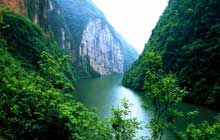
Day Two
Sailing downstream, you will soon arrive at Shibaozhai, a red, multi-storied temple built during the reign of Emperor Qianlong (1736-96). The addition of a wooden staircase has made a substantial improvement on the original means of ascending this cliff-face temple – a few hundred years ago, pilgrims only had an iron chain to help them proceed up the sheer rock-face.
In the afternoon, the boat will dock by the town of Wanxian. Depending on the water level and the allotted time for the boat's passage through the Three Gorges, you may have the opportunity to visit this town. You will be struck by the architectural influence of the West in the form of two local European-style churches, one Catholic, the other Protestant. These hark back to the first Jesuit visitors to Wanxian and to this port town's controversial incorporation within the foreign Treaty Port system in 1902. As dusk settles, the town's rattan and cane market comes alive as buyers and sellers noisily negotiate the sale of handmade summer beds, hats, fans, straw shoes, furniture and basketry. (B, L, D)
Day Three 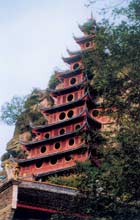
The first of the famous three gorges requires an early morning start. Take a coat and hat with you up on deck, since the wind speeds through the gorge's narrow channel, its rocky banks looming either side in the early morning mist. After breakfast, you will be transferred to smaller boats for an excursion up the gorge at Danning Stream.
In the afternoon, you will ass through the third of the gorges, Wuxia or Shaman's Gorge. High up on its banking cliff-faces, you will observe another of the Yangzi River's curiosities. The local Ba people, one of China's ethnic minorities, centuries ago buried their dead in long wooden coffins pegged to the gorges' sheer rock-faces. Though many have now been removed to local museums, seeing one or two coffins precariously pinned to the rock, you may well wonder how the coffins were pegged there in the first place. To this day art historians are perplexed by this issue.
This evening the boat will reach the Three Gorges Dam. The reason your cruise boat will pass through the first straight into the second of the five stage dual locks is that until 2009 the river level will only have been raised by 40 meters (120 feet) from its original level to 135 meters above sea level (as measured at the dam). After 2009 the water level will be raised an additional 40 meters to 175 m above sea level, at which time all five locks will need to be employed to raise and lower ships between the lower and higher water levels on either side of the dam. (B, L, D)
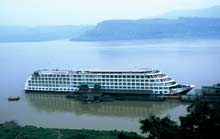 Day Four
Day Four
The day begins with a tour of the Gorges Dam, one of the largest and most controversial dam projects in the world. You will disembark from your boat at Yichang to take a three hour car ride to Wuhan airport, whence you will fly to Beijing. (St. Regis Hotel or Peninsula Palace Hotel) (B, L, D)
Day Five
There is a little time for last minute purchases before your flight home from Beijing international airport. (B)
Please note that B, L, D denotes Breakfast, Lunch Dinner.
Yangzi River tours are done on a private basis only. Visitors interested in a group tour of China, should view our frequent Imperial Touritinerary.
Day One
Depending on what time you arrrive in Xi'an, you might want to take a stroll around the city to get yourself acquainted with this bustling metropolis. Most impressive are the well-preserved city wall and the Bell Tower, the latter being the central-most point of Xi'an. Just south of the Bell Tower is Shuyuanmen, a traditional street full of antique and craft shops. This evening you will be treated to a private dumpling and noodle-making lesson. ( Xi'an Sofitel) (D)
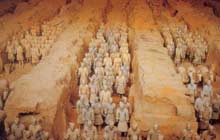 day two
day two
Competing Chinese kingdoms were united for the first time within a single empire by the virile King Zheng, of the Kingdom of Qin. Renamed as Emperor Qin Shihuangdi, this bellicose tyrant was the first to unite the various kingdoms of ancient China, though he is better known to us for his Terracotta Warriors. This morning you can view the the thousands of molded soldiers, officers, horses and wagons, which form part of this famed underground army.
China’s capital during the Han (206BC-220AD) and Tang (618-907AD) dynasties, periods of increasing international exposure, Xi’an became home to motley communities of Nestorian Christians, Zoroastrians, Buddhists, Jews & Muslims – many of whom have left their mark. This afternoon, for example, you will tour the Beilin Museum, a former Confucian Temple which houses an eighth century Christian stone tablet amongst its collection of Chinese Classics. Following this, we will observe the enduring influence of Xi’an’s Muslim community in its Great Mosque and forever-bustling Muslim Quarter. (B, L, D)
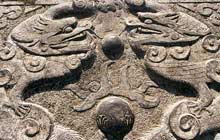
day three
As the capital of twelve dynasties spanning over 1,100 years, Xi’an will certainly not disappoint art enthusiasts. For example, where else would you expect to find wonderful Tang dynasty ceramic horses but in its former capital? Xi'an's well-presented History Museum will help you trace the development of Chinese culture from the third millenium BC to the demise of the Tang dynasty in the tenth century.
Time allowing, you may wish to visit the stunning Yangling Museum, dedicated to the tomb of the Western Han dynasty emperor, Liu Qiu (188 – 141 BCE). The artifacts unearthed here, while similar in purpose to those found in the more famous tomb of Emperor Qin, are far more varied. For example they include courtesans, buildings and farm animals as well as soldiers. Highly stylized, they are also elegant – this is one of the most sophisticated displays you will find anywhere in China. (B, L)
Please note that B, L, D denotes Breakfast, Lunch Dinner.
The above Xi'an tour itinerary is arranged on a private basis only. Visitors interested in a group tour of China, should view our frequentImperial Tour itinerary.
|
Shanghai will take your breath away. Since the early 80's this city has been growing like no other, the Pudong waterfront becoming as emblematic of economic prowess as that of Manhattan or Hong Kong. Last century considered to be the most Western of Chinese cities, Shanghai, should perhaps now be thought of as its most futuristic. Before dinner, you will have a chance to walk or drive along the Bund, taking in some of the loveliest buildings in the city. (Park Hyatt) (B, L, D)
Day Two [Optional – Alternatively, we can arrange a tour elucidating Jewish history in Shanghai; from the Iraqi Sephardi Jews, who traded opium between Bombay and Shanghai in the 1880’s, to the European Ashkenazi’s for whom Shanghai was the only refuge in the Holocaust, Shanghai has long had an intimate relationship with Jewish people. This is a story that can be told on site visiting Shanghai’s remaining synagogues, Jewish areas and great mansions.] En route to lunch, we will travel along sycamore-lined boulevards into the heart of the French Concession. This section of the “Paris of the Orient” now hosts many arts-based businesses and art galleries that we can visit if you so desire. The afternoon will be spent discovering some of Shanghai’s great shopping treasures. This might include a contemporary ceramics shop, the studio of a woman who designs cashmere handbags for Harrods or a fantastic Tibetan carpet shop. After dinner at one of the city’s best new restaurants, you will be taken to witness the marvelous stunts of the Acrobatic Show. (B, L, D) [Optional– If you’re interested in learning the secrets to preparing a perfect Chinese meal, we can arrange for a cooking lesson inside of an old French Concession home. Here you will learn to prepare dishes that one would eat in a typical Shanghainese home.]
Day Three [Optional – Should you wish, we can also arrange a private dinner – catered by Jean Georges – inside the cupola of an Art Deco building on the Bund with a magnificent view over the harbor. This set-menu meal will be designed and catered by Jean Georges.] Please note that B, L, D denotes Breakfast, Lunch Dinner. City tours are arranged on a private basis only. Visitors interested in a group tour of China, should view our frequent Imperial Tour itinerary. The above is a sample itinerary for Shanghai. All private tour itineraries can be modified to meet your travel schedule and specific interests. |
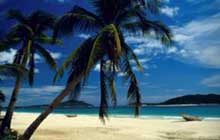 Day One
Day One
Today you will be transferred to the airport in time to catch a flight to Sanya, the southernmost city of the tropical island of Hainan. In the Ming dynasty, pirates and criminals were exiled to this barren atoll, far from the benefits of civilization in the South China Sea. These days, people can’t wait to escape here: high quality international resorts, located along the clean white sand beaches and coves, provide a convenient venue for easy relaxation and the tempting warm blue sea hosts a variety of water sports from snorkeling to sailing to windsurfing. (Please note that the China Host will not travel with you to Sanya). (Ritz-Carlton Hotel – Deluxe Ocean View Room OR Garden Villa) (B)
Day Two
Sanya is the perfect place to recharge and revitalize. You will have the day at leisure to enjoy the pristine white sands and beaches of this tropical island paradise. (B)
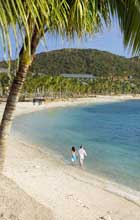 Day Three
Day Three
Day at leisure. If you desire, we will organize a private dinner for you on the white sand beach. As the sun sets, with the warm waves unfurling in wide fans on the shore, enjoy a delicious meal of fresh, local seafood. (B)
Day Four
Today you will transfer to the airport in time for a flight to your next destination. (B)
Please note that B, L, D denotes Breakfast, Lunch, and Dinner
Sanya tours are offered on a private basis only. Visitors interested in a group tour of China, should view our frequent Imperial Tour itinerary.
Day One
This afternoon, a flight takes you to Lijiang . (Banyan Tree Hotel – Garden Villa Rooms) (D)
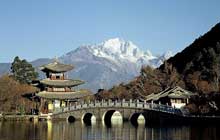 Day Two
Day Two
Founded in the shadow of snow-topped Jade Dragon Mountain , Lijiang rose to prominence 500 years ago as an entrepôt on the dangerous, bandit-infested Tea and Horse caravan route. In order to beat the crowds that quickly congest the small, historic center, we strongly recommend you leave the hotel early this morning. As you wander the idyllic town center , situated on the dry soils of the lower Tibetan plateau, you might admire the apparent ease with which stream water has been channeled through its ancient, paved streets. The facility of the Naxi people, who founded Lijiang, to adopt other cultures' ideas is in evidence at the Daobaoji Temple at Baishawhere three religions are celebrated side by side in Ming-dynasty (1368 – 1644) frescoes.
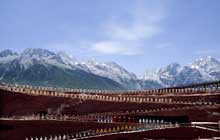 The Tea and Horse caravan route is brought to life in the Zhang Yimou-directed extravaganza " Lijiang Impressions ". Presented on a specially-built stage on the slopes of Jade Dragon Mountain , this show uses hundreds of local farmers, drawn from various local ethnic groups, to illustrate the cultural traditions of the region. We return to the hotel mid-afternoon to provide you with a two hour treatment at the Banyan Tree Hotel's spa.
The Tea and Horse caravan route is brought to life in the Zhang Yimou-directed extravaganza " Lijiang Impressions ". Presented on a specially-built stage on the slopes of Jade Dragon Mountain , this show uses hundreds of local farmers, drawn from various local ethnic groups, to illustrate the cultural traditions of the region. We return to the hotel mid-afternoon to provide you with a two hour treatment at the Banyan Tree Hotel's spa.
(B, T, D)
Day Three
This morning has been left free. You might wish to return to Lijiang's ancient town center, choose to bike to Baisha along the valley floor, or further investigate the delights of the Banyan Tree spa. (B, L)
Please note that B, L, T, D denotes Breakfast, Lunch, Tea and Dinner.